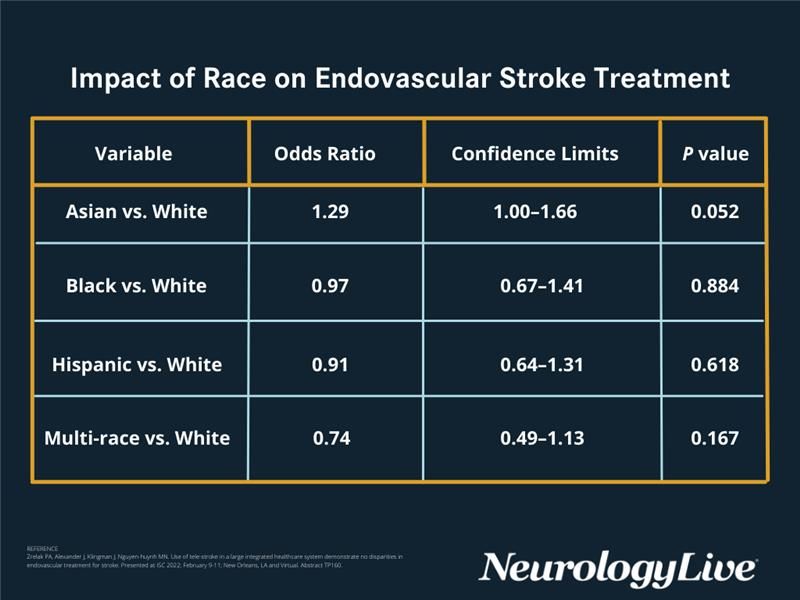Article
Telestroke Implementation, Standardized Workflow Facilitate Equitable Endovascular Treatment
Author(s):
Investigators found that increased age, greater initial NIHSS score, arrival by EMS, and shorter time to ED arrival all contributed to increased treatment rates.
Patricia A. Zrelak, PhD, RN

Data presented at the 2022 International Stroke Conference (ISC), February 9-11, in New Orleans and virtual, suggest that implementing telestroke, in addition to standardized workflows, in facilities contributed to the provision of equitable care regarding race and gender on endovascular treatment odds.1
Investigators, led by Patricia A. Zrelak, PhD, RN, clinical practice consultant, Comprehensive Stroke Center, Kaiser Foundation Hospital, in Sacramento, California, enrolled 1519 patients in the study, all of whom were seeking care for suspected acute stroke and diagnosed with large vessel occlusion (LVO) between Jan 1, 2016, and Dec 31, 2019, at 1 of 21 Northern Californian emergency departments (EDs).
A total of 918 patients of the 1519 patients with LVO underwent endovascular treatment. Increased age (odds ratio [OR], 0.98; 95% CI, 0.98-0.99; P = .000), an initial National Institutes of Health Stroke Scale score greater than 6 (OR, 7.89; 95% CI, 5.85-10.64; P <.0001), arrival to the ED by emergency medical service, and shorter time to ED arrival (OR, 0.92; 95% CI, 0.90-0.94; P <.0001) were all associated with increased treatment rates, as anticipated by investigators.
In multivariate models, investigators did not observe differences in sex (OR, 1.03; 95% CI, 0.79-1.36; P = .808), healthcare membership (OR, 0.91; 95% CI, 0.64-1.31; P = .623), or race (multi-race vs white: OR, 0.74; 95% CI 0.49-1.13; P = .167) in those who received endovascular stroke treatment when compared with those that did not (TABLE). When considering 90-day mortality rates by race (P = .085), there were no differences, and nontreatment was found to be primarily associated with the patient or family refusal or poor baseline functioning.
TABLE. Impact of Race on Endovascular Stroke Treatment. Click to enlarge.

“Race and sex disparities have been reported in endovascular stroke treatment, the most effective treatment to prevent long-term disability from stroke associated with large vessel occlusion (LVO),” Zrelak et al wrote. “In this study, we sought to determine if there are racial and sex disparities in endovascular stroke treatment for patients with acute ischemic stroke due to LVO across 21 community hospitals, part of an integrated delivery system, using a centralized telestroke service and standardized process for rapid stroke evaluation and treatment.”
Patients were excluded from the study if they were younger than 18 years or if they had a canceled stroke alert. Zrelak et al utilized Logistic regression (SAS proc genmod) for multivariate models.
In addition to offering benefits for patients, telestroke also generates opportunities for physicians. In recognition of National Women Physicians Day on Feb 3, 2022, Theresa Sevilis, DO, wrote about her decision to go into a career in medicine as a woman, homing in on her nontraditional path in telestroke, which offered the work-life balance she was seeking.
For more coverage of ISC 2022, click here.




